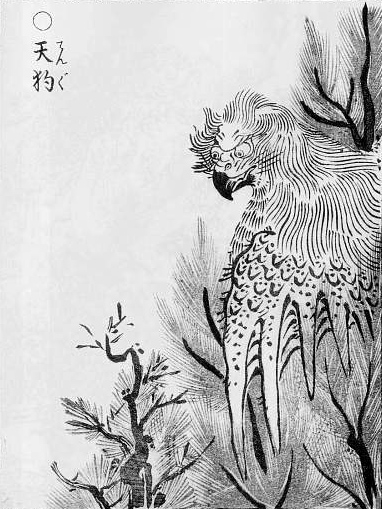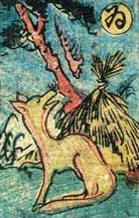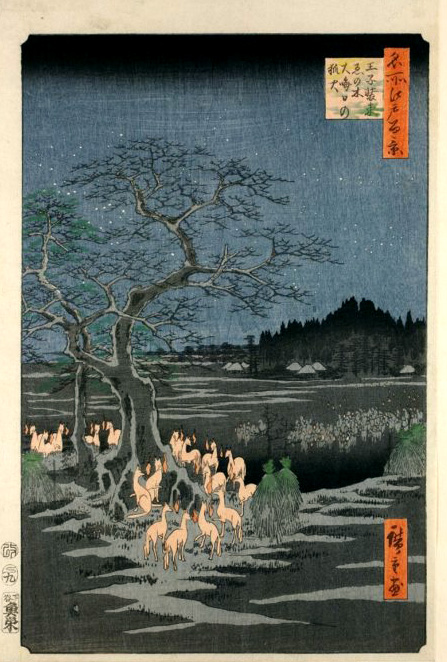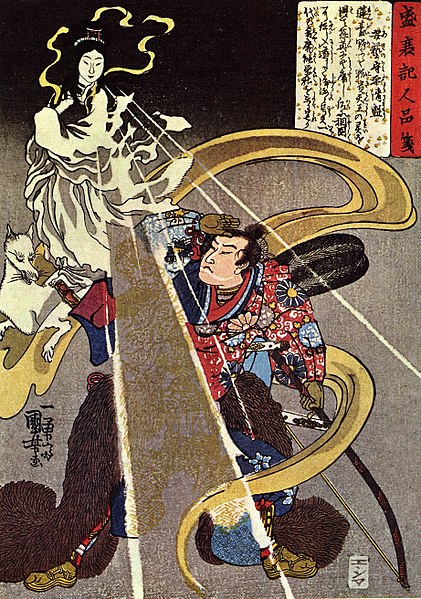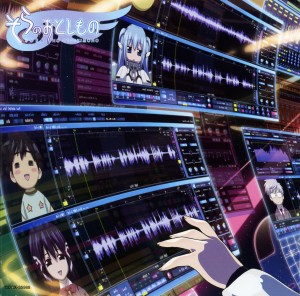
Track List
1. 岬めぐり (Misaki Meguri)
2. 太陽がくれた季節 (Taiyou ga Kureta Kisetsu)
3. 戦士の休息 (Senshi no Kyuusoku)
4. ゆけ!ゆけ!川口浩!! (Yuke! Yuke! Kawaguchi Hiroshi!!)
5. 夏色のナンシー (Natsuiro no Nancy)
6. ふり向くな君は美しい (Furimuku na Kimi ha Utsukushii)
7. ワイルドセブン (Wild Seven)
8. 初恋 (Hatsukoi)
9. 僕等のダイアリー (Bokura no Diary)
10. チャンピオン (Champion)
11. 赤い花 白い花 (Akai Hana Shiroi Hana)
12. 春一番 (Haruichiban)
13. エンディング Ver.1.0~XIV ノンストップメドレー! (Ending Ver.1.0~XIV Nonstop Medley!) *
* bonus track, a 21-minute long medley of the TV-size versions of all the ending themes, including Soba ni Irareru Dakede. They aren’t interlaced nicely like in the Macross Frontier medleys, it’s just fade out fade in. So it’s kinda pointless.
All of these songs are covers of famous songs from the past. It skips from Ver.XII to Ver.XIV, so chances are that there isn’t going to be a new song next week, and that the ‘dangerous ep14′ really will be released as an OVA.
A character album is going to be released Feb. 3, 2010.
This post is pretty long, so I’m going to try out using page jumps. Click the name of the song you want the lyrics for, and you’ll hopefully jump directly there. It’ll probably only work when you’re viewing the full post though (not just the excerpt on the home page). This will be implemented for all future posts.
—————————————-
岬めぐり (Misaki Meguri)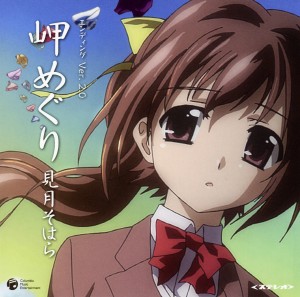
Mitsuki Sohara (CV Mina)
あなたがいつか 話してくれた
anata ga itsuka hanashite kureta
岬を僕は たずねて来た
misaki wo boku ha tazunete kita
二人で行くと 約束したが
futari de iku to yakusoku shita ga
今ではそれも かなわないこと
ima de ha sore mo kanawanai koto
岬めぐりの バスは走る
misaki meguri no basu ha hashiru
窓にひろがる 青い海よ
mado ni hirogaru aoi umi yo
悲しみ深く 胸に沈めたら
kanashimi fukaku mune ni shizumetara
この旅終えて 街に帰ろう
kono tabi oete machi ni kaerou
幸せそうな 人々たちと
shiawase sou na hitobito tachi to
岬を回る ひとりで僕は
misaki wo mawaru hitori de boku ha
くだける波の あのはげしさで
kudakeru nami no ano hageshisa de
あなたをもっと 愛したかった
anata wo motto aishitakatta
岬めぐりの バスは走る
misaki meguri no basu ha hashiru
僕はどうして 生きてゆこう
boku ha doushite ikite yukou
悲しみ深く 胸に沈めたら
kanashimi fukaku mune ni shizumetara
この旅終えて 街に帰ろう
kono tabi oete machi ni kaerou
岬めぐりの バスは走る
misaki meguri no basu ha hashiru
窓にひろがる 青い海よ
mado ni hirogaru aoi umi yo
悲しみ深く 胸に沈めたら
kanashimi fukaku mune ni shizumetara
この旅終えて 街に帰ろう
kono tabi oete machi ni kaerou
—————————————-
太陽がくれた季節 (Taiyou ga Kureta Kisetsu)
Ikaros (CV Hayami Saori), Mitsuki Sohara (CV Mina), Satsukitane Mikako (CV Takagaki Ayahi), Sakurai Tomoki (CV Hoshi Souichirou), Sugata Eishiro (CV Suzuki Tatsuhisa)
君は何を今 見つめているの
kimi ha nani wo ima mitsumete iru no
若い悲しみに 濡れた瞳で
wakai kanashimi ni nureta hitomi de
逃げてゆく白い鳩 それとも愛
nigete yuku shiroi hato soretomo ai
君も今日からは 僕らの仲間
kimi mo kyou kara ha bokura no nakama
飛び出そう 青空の下へ
tobidasou aozora no shita he
君は何を今 待ち続けるの
kimi ha nani wo ima machi tsudukeru no
街の片隅で ひざを抱えて
machi no katasumi de hiza wo kakaete
届かないあの手紙 別れた夢
todokanai ano tegami wakareta yume
君も今日からは 僕らの仲間
kimi mo kyou kara ha bokura no nakama
飛び込もう 青春の海へ
tobikomou seishun no umi he
青春は太陽が くれた季節
seishun ha taiyou ga kureta kisetsu
君も今日からは 僕らの仲間
kimi mo kyou kara ha bokura no nakama
燃やそうよ 二度とない日々を
moyasou yo nidotonai hibi wo
燃やそうよ 二度とない日々を
moyasou yo nidotonai hibi wo
—————————————-
戦士の休息 (Senshi no Kyuusoku)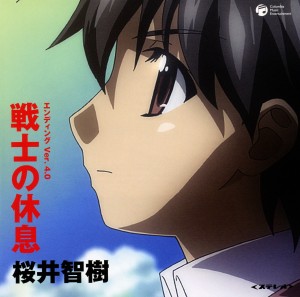
Sakurai Tomoki (CV Hoshi Souichirou)
ありがとう ぬくもりを
arigatou nukumori wo
ありがとう 愛を
arigatou ai wo
かわりに おれの生命を
kawari ni ore no inochi wo
置いてゆけたなら
oite yuketa nara
男は誰もみな 無口な兵士
otoko ha dare mo mina mukuchi na heishi
笑って死ねる人生
waratte shineru jinsei
それさえ あればいい
sore sae areba ii
ああ まぶたを開くな
aa mabuta wo hiraku na
ああ 美しい女(ひと)よ
aa utsukushii hito yo
無理に向ける この背中を
muri ni mukeru kono senaka wo
見られたくはないから
miraretaku ha nai kara
生まれて初めて つらい
umarete hajimete tsurai
こんなにも 別れが
konna ni mo wakare ga
ああ 夢からさめるな
aa yume kara sameru na
ああ 美しい女(ひと)よ
aa utsukushii hito yo
頬に落ちた 熱い涙
hoo ni ochita atsui namida
知られたくはないから
shiraretaku ha nai kara
この世を去る時 きっと
kono yo wo saru toki kitto
その名前 呼ぶだろう
sono namae yobu darou
—————————————-
ゆけ!ゆけ!川口浩!! (Yuke! Yuke! Kawaguchi Hiroshi!!)
Kamon Tatsuo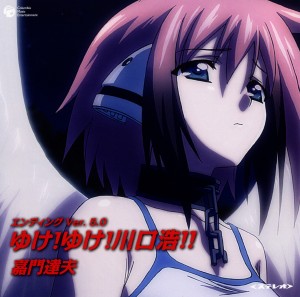
川口浩が洞くつに入る
kawaguchi hiroshi ga hora kutsu ni hairu
カメラマンと照明さんの後に入る
kameraman to shoumei-san no ato ni hairu
洞くつの中には 白骨が転がる
hora kutsu no naka ni ha hakkotsu ga korogaru
何かで磨いた様な ピカピカの白骨が転がる
nanika de migaita youna pikapika no hakkotsu ga korogaru
すると突然頭の上から
suru to totsuzen atama no ue kara
恐いヘビがおそってくる
kowai hebi ga osotte kuru
何故か不思議な事に
nazeka fushigi na koto ni
しっぽから落ちてくる
shippo kara ochite kuru
ヘビの攻撃さけると 動かないサソリがおそってくる
hebi no kougeki sakeru to ugokanai sasori ga osotte kuru
サソリの次は毒グモだ ヒロシは素手で払い落とす
sasori no tsugi ha doku gumo da hiroshi ha sude de harai otosu
ゆけゆけ川口浩 ゆけゆけ川口浩 ゆけゆけ川口浩
yuke yuke kawaguchi hiroshi yuke yuke kawaguchi hiroshi yuke yuke kawaguchi hiroshi
どんとゆけ!!
donto yuke!!
原住民が底なし沼にはまる
genjuumin ga sokonashi numa ni hamaru
溺れている原住民の顔は笑ってる
oboreteiru genjuumin no kao ha waratteru
川口浩は ピラニアにかまれる
kawaguchi hiroshi ha pirania ni kamareru
かまれた素手が 突然画面に大アップになる
kamareta sude ga totsuzen gamen ni dai appu ni naru
さらに未開のジャングルを進む
sara ni mikai no janguru wo susumu
道には何故かタイヤの跡がある
michi ni ha nazeka taiya no ato ga aru
ジャングルの奥地に新人類発見!
janguru no okuchi ni shinjinrui hakken!
腕には時計の跡がある
ude ni ha tokei no ato ga aru
こんな大発見をしながら けっして学会には発表しない
konna daihakken wo shinagara kesshite gakkai ni ha happyou shinai
川口浩の奥ゆかしさに 僕らは思わず涙ぐむ
kawaguchi hiroshi no oku yukashisa ni bokura ha omowazu namida gumu
ゆけゆけ川口浩 ゆけゆけ川口浩 ゆけゆけ川口浩
yuke yuke kawaguchi hiroshi yuke yuke kawaguchi hiroshi yuke yuke kawaguchi hiroshi
どんとゆけ!!
donto yuke!!
大発見をしてジャングルを後にする
daihakken wo shite janguru wo ato ni suru
来る時あれだけいたヘビや サソリ毒グモ いやしない
kuru toki are dake ita hebi ya sasori doku gumo iyashinai
底なし沼さえ消えている
sokonashi numasae kieteiru
ゆけゆけ川口浩 ゆけゆけ川口浩 ゆけゆけ川口浩
yuke yuke kawaguchi hiroshi yuke yuke kawaguchi hiroshi yuke yuke kawaguchi hiroshi
どんとゆけ!!
donto yuke!!
—————————————-
夏色のナンシー (Natsuiro no Nancy)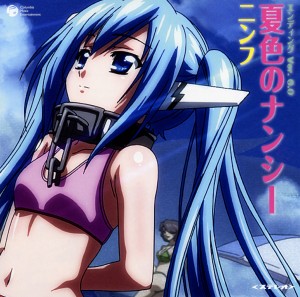
Nymph (CV Nomizu Iori)
※ 恋かな Yes! 恋じゃない Yes!
koi kana Yes! koi janai Yes!
愛かな Yes! 愛じゃない
ai kana Yes! ai janai
風が吹くたび気分も揺れる そんな年頃ね
kaze ga fuku tabi kibun mo yureru sonna toshigoro ne
※※ You & me splashing along the beach
Summer time
Only two of us along the beach
Summer time
プールサイドで瞳を閉じる
pu—rusaido de hitomi wo tojiru
そんな私をあなた気にしてる
sonna watashi wo anata kinishiteru
あなたの後を ついてくだけの
anata no ato wo tsuiteku dake no
女の子からは卒業したみたい
onna no ko kara ha sotsugyou shitamitai
if you love me 夏色の恋人
if you love me natsuiro no koibito
if you love me 夏色のナンシー
if you love me natsuiro no nanshi—
去年とはくちびるが違ってる・・・
kyonen to ha kuchibiru ga chigatteru…
※refrain
※※refrain
青い空からまぶしいSunshine
aoi sora kara mabushii Sunshine
灼けた素肌に ジェラシーかもね
yaketa suhada ni jierashi— kamo ne
あなたは誰かに声かけてるけど
anata ha dareka ni koe kaketeru kedo
本当の愛 気づく時が来るわ
hontou no ai kiduku toki ga kuru wa
if you love me 夏色の恋人
if you love me natsuiro no koibito
if you love me 夏色のナンシー
if you love me natsuiro no nanshi—
さっきから時間さえ止まってる・・・
sakki kara jikan sae tomatteru…
※refrain
- It originally said ‘reflain’ instead of ‘refrain’. I changed it for the sake of readability.
—————————————-
ふり向くな君は美しい (Furimuku na Kimi ha Utsukushii)
Ikaros (CV Hayami Saori), Nymph (CV Nomizu Iori), Mitsuki Sohara (CV Mina), Satsukitane Mikako (CV Takagaki Ayahi), Sakurai Tomoki (CV Hoshi Souichirou), Sugata Eishirou (CV Suzuki Tatsuhisa)
うつ向くなよふり向くなよ 君は美しい
utsumuku na yo furimuku na yo kimi ha utsukushii
戦いに敗れても 君は美しい
tatakai ni yaburetemo kimi ha utsukushii
今ここに青春を刻んだと
ima koko ni seishun wo kizandato
グランドの土を手にとれば
gurando no tsuchi wo te ni toreba
誰も涙を笑わないだろう
dare mo namida wo warawanai darou
誰も拍手を惜しまないだろう
dare mo hakushu wo oshimanai darou
また逢おう いつの日か
mata aou itsu no hi ka
また逢おう いつの日か
mata aou itsu no hi ka
君のその顔を忘れない
kimi no sono kao wo wasurenai
うつ向くなよふり向くなよ 君は美しい
utsumuku na yo furimuku na yo kimi ha utsukushii
くやしさにふるえても 君は美しい
kuyashisa ni furuete mo kimi ha utsukushii
ただ一度 めぐり来る青春に
tada ichido meguri kuru seishun ni
火と燃えて生きて来たのなら
hi to moete ikite kita no nara
誰の心もうてるはずだろう
dare no kokoro mo uteru hazu darou
誰の涙も誘うはずだろう
dare no namida mo sasou hazu darou
また逢おう いつの日か
mata aou itsu no hi ka
また逢おう いつの日か
mata aou itsu no hi ka
君のその顔を忘れない
kimi no sono kao wo wasurenai
—————————————-
ワイルドセブン (Wild Seven)
Sakurai Tomoki (CV Hoshi Souichirou), Sugata Eishirou (CV Suzuki Tatsuhisa)
お前がやれぬことならば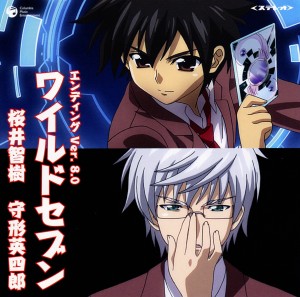
omae ga yarenu koto naraba
俺が この手でやってやる
ore ga kono te de yatteyaru
そうさ この世のどぶさらい
sou sa kono yo no dobusarai
悪にゃめっぽう強いやつ
akunya meppou tsuyoi yatsu
とばすマシーンのシルバーが
tobasu mashi—n no shiruba— ga
暗い闇夜をひきさいた
kurai yamiyo wo hikisaita
何か ありそうな あの七人
nanika ari souna ano shichinin
何か ありそうな ワイルドセブン
nanika ari souna wairudo sebun
もとはと云えば吹きだまり
moto ha to ieba fukidamari
荒れて吠えてた無法者(アウトロー)
arete hoeteta autoro—
今は この世のどぶさらい
ima ha kono yo no dobusarai
悪にむかえば燃えるやつ
aku ni mukaeba moeru yatsu
うなるマシーンが宙を舞い
unaru mashi—n ga chuu wo mai
風の流れをたちきった
kaze no nagare wo tachikitta
何か ありそうな あの七人
nanika ari souna ano shichinin
何か ありそうな ワイルドセブン
nanika ari souna wairudo sebun
もとはと云えば吹きだまり
moto ha to ieba fukidamari
荒れて吠えてた無法者(アウトロー)
arete hoeteta autoro—
何か ありそうな あの七人
nanika ari souna ano shichinin
何か ありそうな ワイルドセブン
nanika ari souna wairudo sebun
—————————————-
初恋 (Hatsukoi)
Ikaros (CV Hayami Saori), Satsukitane Mikako (CV Takagaki Ayahi)
五月雨は緑色 悲しくさせたよ一人の午後は
samidare ha midoriiro kanashikusaseta yo hitori no gogo ha
恋をしてさびしくて
koi wo shite sabishikute
届かぬ想いを暖めていた
todokanu omoi wo atatameteita
好きだよと言えずに 初恋は
suki dayo to iezu ni hatsukoi ha
ふりこ細工の心
furiko saiku no kokoro
放課後の校庭を走る君がいた
houkago no koutei wo hashiru kimi ga ita
遠くで僕はいつでも君を探してた
tooku de boku ha itsudemo kimi wo sagashiteta
浅い夢だから 胸をはなれない
asai yume dakara mune wo hanarenai
夕映えはあんず色 帰り道一人口笛吹いて
yuubae ha anzuiro kaerimichi hitori kuchibue fuite
名前さえ呼べなくて
namae sae yobenakute
とらわれてた心見つめていたよ
tora wareteta kokoro mitsumeteitayo
好きだよと言えずに 初恋は
suki dayo to iezu ni hatsukoi ha
ふりこ細工の心
furiko saiku no kokoro
風に舞った花びらが 水面を乱すように
kaze ni matta hanabira ga miomo wo midasu youni
愛という字書いてみては
ai to iu jikaite mite ha
ふるえていた あの頃
furueteita ano goro
浅い夢だから 胸をはなれない
asai yume dakara mune wo hanarenai
放課後の校庭を走る君がいた
houkago no koutei wo hashiru kimi ga ita
遠くで僕はいつでも君を探してた
tooku de boku ha itsudemo kimi wo sagashiteta
浅い夢だから 胸をはなれない
asai yume dakara mune wo hanarenai
—————————————-
僕等のダイアリー (Bokura no Diary)
Sugata Eishiro (CV Suzuki Tatsuhisa), Satsukitane Mikako (CV Takagaki Ayahi)
たかが恋などと 言ってくれるなよ
taka ga koi nado to itte kureru nayo
僕には大問題だ ややこしくて
boku ni ha daimondai da yaya koshikute
女心にはまるでお手上げさ
onnagokoro ni ha marude ote agesa
大胆不敵な天使 かなわないよ
daitanfuteki na tenshi kanawanaiyo
キスの味はレモン・パイ 肌の香りラベンダー
kisu no aji ha remon pai hada no kaori rabenda—
その気にさせて肩すかし 僕をじらすよ
sono ki ni sasete kata sukashi boku wo jirasuyo
あちらこちらカップルが 翔んで翔んでうわの空
achira kochira kappuru ga tonde tonde uwa no sora
やたら僕を刺激する ドンマイドンマイ今に見てろよ
yatara boku wo shigeki suru donmai donmai ima ni miteroyo
恋はフクザツで やたらせつないよ
koi ha fukuzatsu de yatara setsunaiyo
日毎に大問題だ 悩ましくて
higoto ni daimondai da nayamashikute
甘い言葉セクシーで のぼせすぎてグロッキー
amai kotoba sekushi— de nobosesugite gurokki—
その気にさせてラブ・パンチ 僕にくらわす
sono ki ni sasete rabu panchi boku ni kurawasu
あちらこちらカップルが 翔んで翔んでうわの空
achira kochira kappuru ga tonde tonde uwa no sora
やたら僕を刺激する ドンマイドンマイ今に見てろよ
yatara boku wo shigeki suru donmai donmai ima ni miteroyo
—————————————-
チャンピオン (Champion)
Sakurai Tomoki (CV Hoshi Souichirou) & Tomoko (CV Fujita Saki)
つかみかけた熱い腕を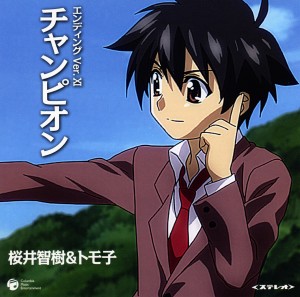
tsukami kaketa atsui ude wo
ふりほどいて君は出てゆく
furihodoite kimi ha dete yuku
わずかに震える白いガウンに
wazuka ni furueru shiroi gaun ni
君の年老いた悲しみを見た
kimi no toshioita kanashimi wo mita
リングに向かう長い廊下で
ringu ni mukau nagai rouka de
何故だか急に君は立ち止まり
nazedaka kyuu ni kimi ha tachidomari
ふりむきざまに俺に
furimukizama ni ore ni
こぶしを見せて寂しそうに笑った
kobushi wo misete sabishisou ni waratta
やがてリングと拍手の渦が
yagate ringu to hakushu no uzu ga
一人の男をのみこんで行った
hitori no otoko wo nomikondeitta
(You’re King of Kings)
立ち上がれ
tachiagare
もう一度その足で立ち上がれ
mou ichido sono ashi de tachiagare
命の炎を燃やせ
inochi no honoo wo moyase
君はついに立ち上がった
kimi ha tsui ni tachiagatta
血に染まった赤いマットに
chi ni somatta akai matto ni
わずかに開いた君の両目に光る
wazuka ni hiraita kimi no ryoume ni hikaru
涙が何かを語った
namida ga nanika wo katatta
獣のように挑戦者はおそいかかる
kemono no youni chousensha ha osoi kakaru
若い力で
wakai chikara de
やがて君は静かに倒れて落ちた
yagate kimi ha shizuka ni taorete ochita
疲れて眠るように
tsukarete nemuru youni
わずかばかりの意識の中で
wazuka bakari no ishiki no naka de
君は何を考えたのか
kimi ha nani wo kangaeta no ka
(You’re King of Kings)
立たないで
tatanaide
もうそれで充分だ
mou sore de juubun da
おお神よ彼を救いたまえ
ookami yo kare wo sukuitamae
ロッカールームのベンチで君は
rokka—ru—mu no benchi de kimi ha
切れたくちびるでそっとつぶやいた
kireta kuchibiru de sotto tsubuyaita
(You’re King of Kings)
帰れるんだ
kaererunda
これでただの男に帰れるんだ
kore de tada no otoko ni kaererunda
これで帰れるんだ
kore de kaererunda
ラィ ラ ラィ ラ ラィ・・・・・・・・・・・・・・・・・・
rai ra rai ra rai………………
—————————————-
赤い花 白い花 (Akai Hana Shiroi Hana)
Ikaros (CV Hayami Saori)
赤い花つんで あの人にあげよ
akai hana tsunde ano hito ni ageyo
あの人の髪に この花さしてあげよ
ano hito no kami ni kono hana sashite ageyo
赤い花 赤い花 あの人の髪に
akai hana akai hana ano hito no kami ni
咲いてゆれるだろう お陽さまのように
saite yureru darou ohi-sama no youni
白い花つんで あの人にあげよ
shiroi hana tsunde ano hito ni ageyo
あの人の胸に この花さしてあげよ
ano hito no mune ni kono hana sashite ageyo
白い花 白い花 あの人の胸に
shiroi hana shiroi hana ano hito no mune ni
咲いてゆれるだろう お月さんのように
saite yureru darou otsuki-san no youni
—————————————-
春一番 (Haruichiban)
Ikaros (CV Hayami Saori), Nymph (CV Nomizu Iori), Mitsuki Sohara (CV Mina)
雪が溶けて川になって 流れてゆきます
yuki ga tokete kawa ni natte nagarete yukimasu
つくしの子がはずかしげに 顔を出します
tsukushi no ko ga hazukashige ni kao wo dashimasu
もうすぐ春ですね
mou sugu haru desu ne
ちょっと気取ってみませんか
chotto kidotte mimasenka
風が吹いて暖かさを 運んで来ました
kaze ga fuite atatakasa wo hakonde kimashita
どこかの子が隣りの子を 迎えに来ました
dokoka no ko ga tonari no ko wo mukae ni kimashita
もうすぐ春ですね
mou sugu haru desu ne
彼を誘ってみませんか
kare wo sasotte mimasenka
泣いてばかりいたって 幸せは来ないから
naite bakari itatte shiawase ha konai kara
重いコート脱いで 出かけませんか
omoi ko—to nuide dekakemasenka
もうすぐ春ですね
mou sugu haru desu ne
恋をしてみませんか
koi wo shite mimasenka
日だまりには雀たちが 楽しそうです
hidamari ni ha suzumetachi ga tanoshi sou desu
雪をはねて猫柳が 顔を出します
yuki wo hanete neko yanagi ga kao wo dashimasu
もうすぐ春ですね
mou sugu haru desu ne
ちょっと気取ってみませんか
chotto kidotte mimasenka
おしゃれをして男の子が 出かけてゆきます
oshare wo shite otoko no ko ga dekakete yukimasu
水をけってカエルの子が 泳いでゆきます
mizu wo kette kaeru no ko ga oyoide yukimasu
もうすぐ春ですね
mou sugu haru desu ne
彼を誘ってみませんか
kare wo sasotte mimasenka
別れ話したのは 去年のことでしたね
wakare banashi shita no ha kyonen no koto deshita ne
ひとつ大人になって 忘れませんか
hitotsu otona ni natte wasuremasenka
もうすぐ春ですね
mou sugu haru desu ne
恋をしてみませんか
koi wo shite mimasenka
雪が溶けて川になって 流れてゆきます
yuki ga tokete kawa ni natte nagarete yukimasu
つくしの子がはずかしげに 顔を出します
tsukushi no ko ga hazukashige ni kao wo dashimasu
もうすぐ春ですね
mou sugu haru desu ne
ちょっと気取ってみませんか
chotto kidotte mimasenka
別れ話したのは 去年のことでしたね
wakare banashi shita no ha kyonen no koto deshita ne
ひとつ大人になって 忘れませんか
hitotsu otona ni natte wasuremasenka
もうすぐ春ですね
mou sugu haru desu ne
恋をしてみませんか
koi wo shite mimasenka
もうすぐ春ですね
mou sugu haru desu ne
恋をしてみませんか
koi wo shite mimasenka

![[SFW]_Mahoromatic_-_Tadaima_Okaeri_-_01_[C88C1679].mkv_snapshot_02.28_[2009.12.27_18.31.26] Morning wake up call](http://gndynames.wordpress.com/files/2009/12/sfw_mahoromatic_-_tadaima_okaeri_-_01_c88c1679-mkv_snapshot_02-28_2009-12-27_18-31-26.jpg)
![[SFW]_Mahoromatic_-_Tadaima_Okaeri_-_01_[C88C1679].mkv_snapshot_02.53_[2009.12.27_18.31.52]](http://gndynames.wordpress.com/files/2009/12/sfw_mahoromatic_-_tadaima_okaeri_-_01_c88c1679-mkv_snapshot_02-53_2009-12-27_18-31-52.jpg)
![[SFW]_Mahoromatic_-_Tadaima_Okaeri_-_01_[C88C1679].mkv_snapshot_04.02_[2009.12.27_18.32.09]](http://gndynames.wordpress.com/files/2009/12/sfw_mahoromatic_-_tadaima_okaeri_-_01_c88c1679-mkv_snapshot_04-02_2009-12-27_18-32-09.jpg)
![[SFW]_Mahoromatic_-_Tadaima_Okaeri_-_02_[E3659199].mkv_snapshot_12.05_[2009.12.27_17.31.23]](http://gndynames.wordpress.com/files/2009/12/sfw_mahoromatic_-_tadaima_okaeri_-_02_e3659199-mkv_snapshot_12-05_2009-12-27_17-31-23.jpg)
![[SFW]_Mahoromatic_-_Tadaima_Okaeri_-_02_[E3659199].mkv_snapshot_14.53_[2009.12.27_18.45.44]](http://gndynames.wordpress.com/files/2009/12/sfw_mahoromatic_-_tadaima_okaeri_-_02_e3659199-mkv_snapshot_14-53_2009-12-27_18-45-44.jpg)
![[SFW]_Mahoromatic_-_Tadaima_Okaeri_-_01_[C88C1679].mkv_snapshot_21.11_[2009.12.28_17.33.25]](http://gndynames.wordpress.com/files/2009/12/sfw_mahoromatic_-_tadaima_okaeri_-_01_c88c1679-mkv_snapshot_21-11_2009-12-28_17-33-25.jpg)
![[SFW]_Mahoromatic_-_Tadaima_Okaeri_-_01_[C88C1679].mkv_snapshot_22.06_[2009.12.28_17.34.34]](http://gndynames.wordpress.com/files/2009/12/sfw_mahoromatic_-_tadaima_okaeri_-_01_c88c1679-mkv_snapshot_22-06_2009-12-28_17-34-34.jpg) [/caption]
[/caption]
![[SFW]_Mahoromatic_-_Tadaima_Okaeri_-_02_[E3659199].mkv_snapshot_09.47_[2009.12.28_18.58.59]](http://gndynames.wordpress.com/files/2009/12/sfw_mahoromatic_-_tadaima_okaeri_-_02_e3659199-mkv_snapshot_09-47_2009-12-28_18-58-59.jpg)
![[SFW]_Mahoromatic_-_Tadaima_Okaeri_-_02_[E3659199].mkv_snapshot_09.50_[2009.12.28_18.59.21]](http://gndynames.wordpress.com/files/2009/12/sfw_mahoromatic_-_tadaima_okaeri_-_02_e3659199-mkv_snapshot_09-50_2009-12-28_18-59-21.jpg)
![[SFW]_Mahoromatic_-_Tadaima_Okaeri_-_02_[E3659199].mkv_snapshot_09.56_[2009.12.28_18.55.53] Although, the ensuring carnage is often hilarious](http://gndynames.wordpress.com/files/2009/12/sfw_mahoromatic_-_tadaima_okaeri_-_02_e3659199-mkv_snapshot_09-56_2009-12-28_18-55-53.jpg)
![[SFW]_Mahoromatic_-_Tadaima_Okaeri_-_01_[C88C1679].mkv_snapshot_16.44_[2009.12.28_19.05.29]](http://gndynames.wordpress.com/files/2009/12/sfw_mahoromatic_-_tadaima_okaeri_-_01_c88c1679-mkv_snapshot_16-44_2009-12-28_19-05-29.jpg)
![[SFW]_Mahoromatic_-_Tadaima_Okaeri_-_02_[E3659199].mkv_snapshot_20.59_[2009.12.28_19.01.28]](http://gndynames.wordpress.com/files/2009/12/sfw_mahoromatic_-_tadaima_okaeri_-_02_e3659199-mkv_snapshot_20-59_2009-12-28_19-01-28.jpg)
![[SFW]_Mahoromatic_-_Tadaima_Okaeri_-_02_[E3659199].mkv_snapshot_22.11_[2009.12.27_17.42.49] Anyone know around which part of the show this OVA takes place? (Judging from Mahoro's days left)](http://gndynames.wordpress.com/files/2009/12/sfw_mahoromatic_-_tadaima_okaeri_-_02_e3659199-mkv_snapshot_22-11_2009-12-27_17-42-49.jpg)
 It’s only a work in progress, but you can see where it helps to be able to cleanly select your line-art for re-colouring. I’ll upload the finished pic when its done!
It’s only a work in progress, but you can see where it helps to be able to cleanly select your line-art for re-colouring. I’ll upload the finished pic when its done!

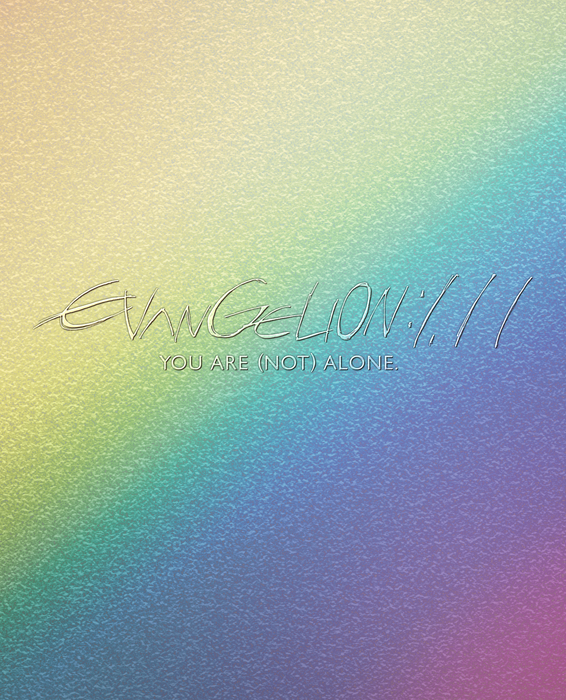
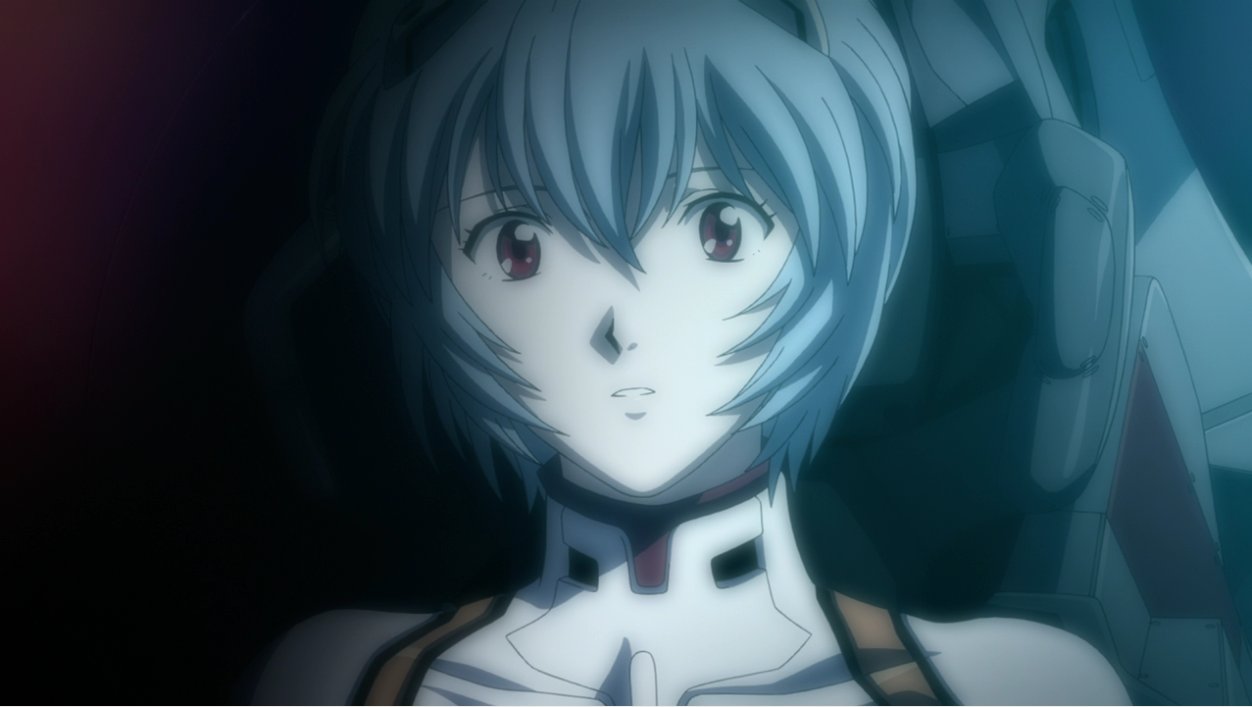
 Recochoku conducted the survey on the Internet from May 28 to June 1 on an unspecified number of its users.Here are the top 10 results for the annual survey of “The Character I Want to Be My Groom” [according to rank]:
Recochoku conducted the survey on the Internet from May 28 to June 1 on an unspecified number of its users.Here are the top 10 results for the annual survey of “The Character I Want to Be My Groom” [according to rank]:
















